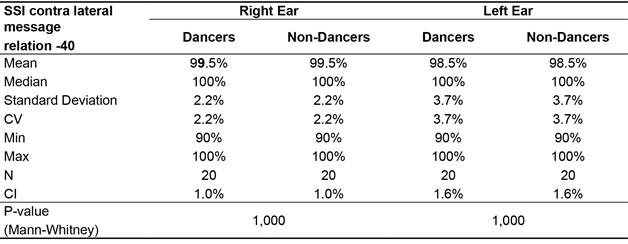Abstract:
PURPOSE:
to assess the ability of auditory temporal resolution and identification of sentences with competitive message in dancers.
METHODS:
this is a prospective study that evaluated 40 subjects distributed in two groups: group 1 (dancers) and group 2 (non-dancers). The assessment instruments in the auditory processing were Gaps-in-noise test (GIN) and Synthetic Sentence Identification test (SSI).
RESULTS:
the gap thresholds of both groups ranged 3-6 ms and did not show a statistical significant difference when comparing the groups. There was a statistically significant difference when comparing the percentage of identifying gaps between the two groups, and the group of dancers had a mean higher than the group of non- dancers. The sentence recognition test in monotic (rel -10dB) showed results ranging from 50% to 100% for the group of dancers and 40% up to 100% for non-dancers. The dance early age (before or after seven years) did not influence the performance of the studied tests. There was no correlation between the variables from findings of tests studied in considering the group of dancers at dance time.
CONCLUSION:
dance positively influenced the auditory ability of temporal resolution, since the group of dancers had performed better than the non-dancers group. The dance did not influence the auditory ability of figure-ground.
Keywords:
Auditory Tests; Auditory Perception; Neuronal Plasticity; Dancing; Hearing; Neuropsychology




